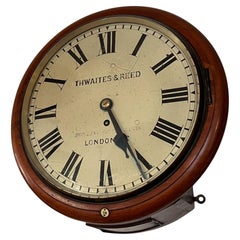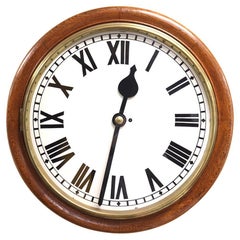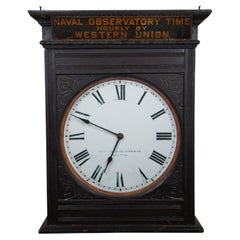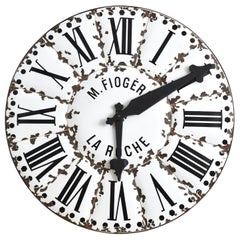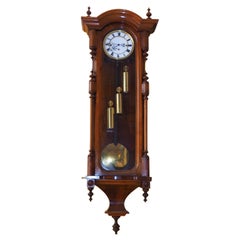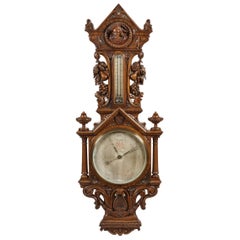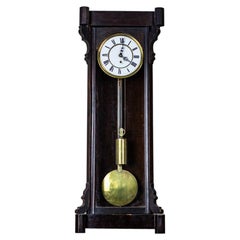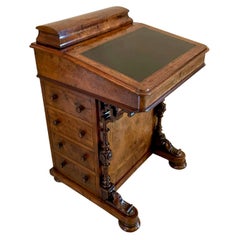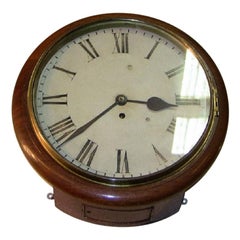Late Victorian Wall Clocks
1
6
to
1
5
1
6
6
6
208
168
163
48
41
36
35
14
13
10
10
9
9
5
5
5
4
3
4
2
1
1
Height
to
Width
to
6
4
2
2
2
5
3
1
1
1
1
Style: Late Victorian
Thwaites and Reed 19th Century Wall Clock
Located in London, GB
This beautiful wall clock was made by Thwaites and Reed in the late 19th century.
The case is mahogany and numbered 118 with a small ivorine plaque - these clocks were made for establishments such as the Inns of Court and the Bank of England in London. The company were also employed to service them.
The clock is wound with the original key and has a lovely deep tick tock (no chime). The diameter of the clock face is 30cm.
Thwaites and Reed are the epitome of a traditional English antique company...
Category
Late 19th Century British Antique Late Victorian Wall Clocks
Materials
Brass
Goliath Single Fusee Dial Clock or Station Clock
Located in Amersham, GB
This giant single fusee dial clock would have been made for a public space like a railway station. Made By Swinden and Sons of Birmingham, it has a su...
Category
1880s English Antique Late Victorian Wall Clocks
Materials
Brass, Steel
Rare Self Winding Clock Co Naval Observatory Time Western Union Wall Clock 26"
Located in Dayton, OH
Antique Western Union, Naval Observatory Time, self winding clock. Features a tall wooden case with carved corners and pediment mounted with tin sign reading "Naval Observatory Time Hourly By Western Union. White metal face with black Roman numerals and hands. Interior of case labeled "Property of Self-Winging Clock Co New York" and serial number on metal tag as well as on works. F Style / Vibrator movement, Serial Number 92630 (likely manufactured before 1917). Patented Oct. 4, 1898 by the Self Winding Clock Company. Fitted with Archer AC Adapter.
"The Self Winding Clock Company (SWCC) of New York began business in 1886 marketing their own electro-mechanical clocks based on the 1884 electro-mechanical clock patent of one of the company founders, Chester Pond (1844-1912). The innovative principle of this clock mechanism was the incorporation of a small electric winding motor that automatically rewound the mainspring after the clock ran for one hour. The clocks were powered by batteries. The batteries would last at least one year. By being automatically rewound each hour, the strain on the mechanism was kept to a minimum, resulting in a very accurate timepiece. At about the same time SWCC began selling clocks, Pond was developing an electro-mechanical synchronizer attached to the clock movement that could synchronize the clock hands to an accurate time source. The synchronization occurs when a remote, precisely timed, electrical impulse is sent via wires connected to the individual clocks. By 1887 the synchronizers had been so improved that the Self Winding Clock Company could not only market individual clocks but also sell entire synchronized clock systems. By the 1960’s the days of individual elegant mechanical timepieces and synchronized time systems were over. SWCC ceased operations in the late 1960’s. All company records and inventories were relegated to the trash pile.
The STYLE “F”, or as commonly referred to, the VIBRATOR movement was developed by Frederick M. Schmidt in the late 1890’s. By 1898 the “F” movement was being installed in almost all SWCC clocks. The movement has a Graham dead beat escapement. The “F” movement incorporates both the time train and winding motor in one set of plates. The motor used a single pair of coils. It was more reliable and easier to service than the rotary movement. The mainspring is re-wound after running for one hour. The vibrating armature oscillates up and down carrying a winding lever with a pawl that turns the winding wheel. The “F” movement was used in individual clocks and in clocks that were part of synchronized systems. It was made in 60, 80,120 and 140 beat versions. There were virtually no changes to the movement in 60 plus years the movement was in production. Almost all Style “F” movements wound on 3 volts DC.
Style “F” movement serial numbers started in the 33,000’s and the first movements were probably made in 1898. The earliest plates had patent dates of 1891, 1892 & 1898. Serial numbers with these patent dates go up to the 63,000’s and were made before 1908. By 1908 the plates only had the 1898 patent date. By using catalog images of movement serial numbers it can be concluded that movements with serial numbers up to 112,000 were made in or before 1917. Movements with serial numbers up to 196,000’s were made in or before 1929. The single patent date serial numbers go as high as 220,000’s. Then there appears to be a large numbering gap. Finally, movements appear with no patent dates and serial numbers with the prefix FR. These numbers start at 300,000 but only continue to about 302,000. Start again at 400,000 and continue to about 402,000. Based on the large serial number gaps, the total number of “F” movements manufactured is probably around 200,000. They were manufactured between 1898 and possibly as late as the 1950’s.
SWCC both sold clocks to and partnered with their biggest customer, Western Union in a nationwide distribution of precisely accurate “Naval Observatory Time” clocks. These either 120 or 140 beat Naval Observatory clocks...
Category
Early 20th Century Late Victorian Wall Clocks
Materials
Metal
Large Original Enamel Antique French Tower Clock Face
Located in Stockbridge, GB
Large Original Enamel Antique French Tower Clock Face
A stunning turn of the century original turret clock face from La Roche, France. The clock face...
Category
Mid-20th Century French Late Victorian Wall Clocks
Materials
Steel, Enamel
Vienna Regulator, Grand Sonnerie Wall Clock in Walnut
By Vienna Bronze
Located in Perth, GB
In the noted horology book "Britten's Old Clocks and Watches", G.H. Baillie defines a Grand Sonnerie movement as follows:
"A form of quarter-striking in which the hour last struck is also repeated at each hour."
It works like this, striking the quarter-hour on one gong and the hour on a second, slightly lower-toned gong:
At 3:15 the clock strikes once on the higher chime to indicate the quarter hour, followed by three strikes on the lower chime to indicate the hour.
At 3:30 the clock strikes two times on the higher chime (half-hour), followed by three chimes on the lower gong (hour).
This way, if you are within hearing distance of the clock, day or night, you can tell exactly what time it is at each quarter hour
A "petite sonnerie...
Category
Late 19th Century Austrian Antique Late Victorian Wall Clocks
Materials
Walnut
Carved Oak Barometer by Cetti of Brook Street, London
Located in London, GB
The barometer, of aneroid type, signed by the maker and having a thermometer above is house within an extensively carved 'banjo' form case, incorporating fruits and foliates, with a ...
Category
Late 19th Century British Antique Late Victorian Wall Clocks
Materials
Oak
Related Items
19th-Century Pendulum Wall Clock
Located in Opole, PL
We present you this chain pendulum clock with a gravity winding mechanism with a single weight.
The case bears normal traces of long years of use.
It is intended to be renovated.
...
Category
Late 19th Century Antique Late Victorian Wall Clocks
Materials
Brass
Antique Victorian Burr Walnut Inlaid Freestanding Davenport
Located in Suffolk, GB
Antique Victorian burr walnut inlaid freestanding davenport having a shaped inlaid top opening to reveal a fitted interior, original leather writing slope crossbanded in burr walnut ...
Category
19th Century English Antique Late Victorian Wall Clocks
Materials
Walnut
Masterly Carved Black Forest Wall Barometer with Fern Plants and Eagle Sculpture
Located in Lisse, NL
Hand carved, solid walnut antique barometer with maker's mark.
This rare Black Forest barometer depicting an incredibly detailed and finest quality also has the most beautiful patin...
Category
Early 20th Century Swiss Late Victorian Wall Clocks
Materials
Brass, Zinc
Free Shipping
H 22.4 in W 9.5 in D 2.15 in
Jules Vieillard Chinoiserie Mantel Clock
Located in New York, NY
French (Mid-19th Century) Chinoiserie design faience 6-sided mantel clock with foo dog top and elephant heads on sides. (by JULES VIEILLARD, Bordeau France) (Not working)
Category
19th Century English Antique Late Victorian Wall Clocks
Materials
Metal
Antique 19th Century Rosewood Banjo Barometer
Located in Suffolk, GB
Antique 19th century rosewood banjo barometer having a quality rosewood case with a onion shaped top, nine inch silvered dial with original hands and thermometer, fitted hygrometer, ...
Category
19th Century European Antique Late Victorian Wall Clocks
Materials
Other
Antique Mahogany 8 Day Painted Face Longcase Clock
Located in Suffolk, GB
Outstanding antique mahogany 8 day painted face longcase clock signed Johnson Knaresboro with a swan-neck pediment with original brass finials. This a stunning piece, very decorative...
Category
1850s English Antique Late Victorian Wall Clocks
Materials
Brass
Vintage Rare Postmodern Wall Clock by Kienzle
Located in San Diego, CA
Incredible time piece. Great design on this wall clock by Kienzle, made in Germany circa late 1970's all plastic with calendar. The piece is streamlined and highlights it’s specific...
Category
1970s German Vintage Late Victorian Wall Clocks
Materials
Plastic
Antique found time wall clock/regulator from around 1880
Located in Berlin, DE
Antique found time wall clock/regulator from around 1880
Solid wood, richly carved with brass pendulum.
Movement needs to be checked.
Category
Late 19th Century German Antique Late Victorian Wall Clocks
Materials
Nutwood, Oak
Large French Turn of the Century White Enamelled Clock Face from La Roche
Located in London, Park Royal
An original town centre clock face from La Roche France, circa 1900. The bombe shaped enamel white face provides a striking contrast to the black Roman numerals. A classic and grand ...
Category
Early 20th Century French Late Victorian Wall Clocks
Materials
Iron
Measured Time Clock by Isamu Noguchi
Located in Oklahoma City, OK
The Hawkeye Measure Time Clock Timer, a masterpiece by Isamu Noguchi, stands as a testament to both form and function. In impeccable working order, this timekeeping gem has undergone...
Category
1930s American Vintage Late Victorian Wall Clocks
Materials
Metal
Rare 1980s battery-operated world time table clock by Kienzle
Located in München, DE
Rare 1980s brass world time table clock by Kienzle.
Goes back to the design of Heinrich Johannes Möller. Made in Germany.
Kienzle is the oldest clock company in Germany.
Housing is m...
Category
1980s German Vintage Late Victorian Wall Clocks
Materials
Metal, Brass
Large Siemens Halske Factory, Station or Workshop Wall Clock
By Siemens
Located in Vienna, AT
Plastic frame with the acrylic front made in Germany in the 1970s.
Formerly a slave clock, it is now fitted with a modern quartz movement with a battery.
Category
1970s German Vintage Late Victorian Wall Clocks
Materials
Plastic, Acrylic
Previously Available Items
19th Century British Mahogany Schoolhouse or Railway Wall Clock
Located in Dallas, TX
Lovely 19th century British mahogany schoolhouse or railway wall clock.
circa 1880-1890.
No makers mark……beautiful original dial…..pendulum 8 ...
Category
Late 19th Century English Antique Late Victorian Wall Clocks
Materials
Brass
Large Copper and Iron Turret Clock Dial Face with Original Copper Hands
Located in Belper, Derbyshire
A lovely and rare large Victorian copper and iron clock dial reclaimed from a lace mill, complete with original copper hands with bracket and part motion work. It is in a lovely pati...
Category
Late 19th Century British Antique Late Victorian Wall Clocks
Materials
Copper, Iron
19th Century British 8 Day Fusee Railway or School Wall Clock
By J. Walker
Located in Dallas, TX
Really good British wall clock, made circa 1880 for use in a railway station house or a school house.
This is a superb clock!
Made by a well-known ...
Category
Late 19th Century English Antique Late Victorian Wall Clocks
Materials
Brass
19 Century American Inlaid Regulator Wall Clock
Located in Dallas, TX
Gorgeous American 19th century timepiece, with an Irish connection!!
Made from exotic hardwood and beautifully inlaid with various wood patterns of satinwood etc. In the style of Tu...
Category
Late 19th Century American Antique Late Victorian Wall Clocks
Materials
Birch, Ebony, Maple, Rosewood
Late Victorian Oak 12" Fusee Wall Clock
Located in Whaley Bridge, GB
Sn3245, late Victorian wall clock, having white enamel dial with Roman numerals, original hands, brass bezel and single fusee movement in oak case, circa 1890
The movement has bee...
Category
1890s English Antique Late Victorian Wall Clocks
Materials
Oak
Gustav Becker Style Victorian Wall Clock with Key and Pendulum Signed Adler
By Adler Gong
Located in Stamford, CT
Fine 19th-early 20th century Gustav Becker style Victorian wall clock with key and pendulum. This finely carved and intricately worked case depicts the Victorian golden age at its hi...
Category
Early 20th Century German Late Victorian Wall Clocks
H 46 in W 17.38 in L 46 in
Large Cadran Vintage Clock Face
Located in Copenhagen K, DK
Handsome and large vintage iron clock face, called “CADRAN”. Painted white, with beautiful roman numerals in blue shades. Typically from a church to...
Category
Early 20th Century French Late Victorian Wall Clocks
Materials
Iron
Large Copper and Iron Turret Clock Dial Face with Original Copper Hands
Located in Belper, Derbyshire
A lovely and rare large Victorian copper and iron clock dial reclaimed from a lace mill, complete with original copper hands with bracket and part motion work. It is in a lovely pati...
Category
Late 19th Century British Antique Late Victorian Wall Clocks
Materials
Copper, Iron
Late Victorian wall clocks for sale on 1stDibs.
Find a broad range of unique Late Victorian wall clocks for sale on 1stDibs. Many of these items were first offered in the Mid-20th Century, but contemporary artisans have continued to produce works inspired by this style. If you’re looking to add vintage wall clocks created in this style to your space, the works available on 1stDibs include decorative objects, asian art and furniture and other home furnishings, frequently crafted with wood, enamel and other materials. If you’re shopping for used Late Victorian wall clocks made in a specific country, there are Europe, Austria, and France pieces for sale on 1stDibs. It’s true that these talented designers have at times inspired knockoffs, but our experienced specialists have partnered with only top vetted sellers to offer authentic pieces that come with a buyer protection guarantee. Prices for wall clocks differ depending upon multiple factors, including designer, materials, construction methods, condition and provenance. On 1stDibs, the price for these items starts at $5,008 and tops out at $18,303 while the average work can sell for $9,692.
Recently Viewed
View AllMore Ways To Browse
American Clock Antique Clocks
American Antique Clocks
American Antique Clocks American Antique Clocks
Antique American Clocks Clocks
American Antique Clock
Antique American Clocks
Antique American Clocks Antique Clocks
American Clocks Antique Clocks
Large French Wall Clock
Vintage Iron Clock
Old Vintage Clocks
Retro Brass Wall Clock
Large German Clocks
Post Office Clock
Large Wall Clocks Antique
Large Antique Wall Clock Clocks
Large Antique Wall Clock
Large Antique Wall Clocks
